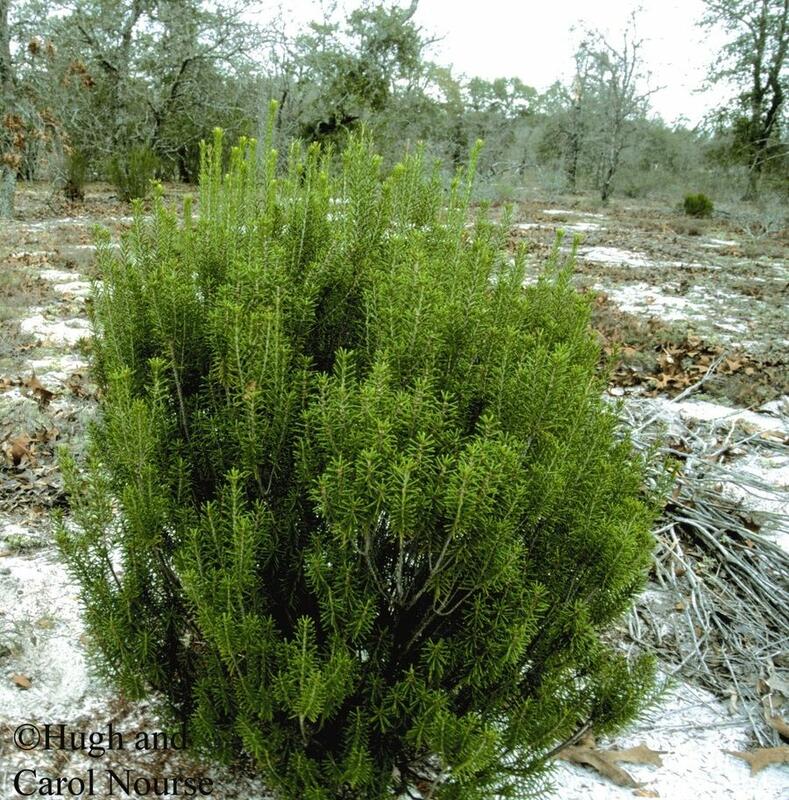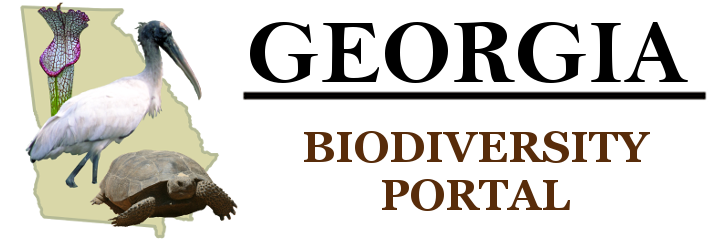







Loading profile. Please wait . . .
Ceratiola ericoides Michx.
Rosemary




Federal Protection: No US federal protection
State Protection: Threatened
Global Rank: G4
State Rank: S2
Element Locations Tracked in Biotics: Yes
SWAP 2015 Species of Greatest Conservation Need (SGCN): Yes
SWAP 2025 Species of Greatest Conservation Need (SGCN): Yes
2025 SGCN Priority Tier: High Conservation Concern
Element Occurrences (EOs) in Georgia: 37
Habitat Summary for element in Georgia: Ohoopee Dunes; deep sandridges
Evergreen shrub up to 8 feet (2.5 meters) tall, rounded, and dense with erect branches; older branches have gray, shredding bark and rough leaf scars; young twigs are densely hairy. Leaves are 0.3 - 0.6 inch (8 - 15 mm) long, dark green, needle-like, in pairs set at right angles to each other and appearing to be in whorls of 4 or 6 needles when viewed from the end of the twig; leaves smell strongly of rosemary or, during hot weather, of honey. Female flowers and male flowers are on separate plants; they are both small, papery, yellow to brown, and clustered in the angle between leaf and twig, sometimes filling nearly all the spaces between leaves at the ends of the twigs. Fruits are about 0.1 inch (3 mm) wide, round, yellow, with 2 seeds.
Rosemary, also known as Florida Rosemary, Sandhill Rosemary, and Sand-heath, resembles no other plant in Georgia’s scrub habitats. Another aromatic, needle-leaved shrub found in scrub, Ohoopee Wild Basil (Ashe’s Savory, Calamintha ashei), is less than 2 feet (60 cm) tall and has gray-green needles and showy pink flowers. It is rare; for more information, see: https://georgiabiodiversity.org/portal/profile?group=plants&es_id=18031
There are no other species in this genus, which is in the family Empetraceae, or Crowberry Family.
Extremely dry sandhills and sand ridges along the east sides of several Coastal Plain rivers; with Woody Goldenrod (Chrysoma pauciflosculosa), dense patches of lichens, and large areas of bare sand.
Sandhill Rosemary is dioecious: the female and male flowers are on separate plants. They bloom from early spring to early summer. Sandhill Rosemary produces large crops of seeds; plants studied in Florida scrub begin to set seed between 10 - 15 years, and seed production declines between 20 - 30 years. Fruits are eaten by ants, mice, and birds.
Sandhill Rosemary quickly appears after a disturbance, whether small or large, and especially after a fire. It responds to fire with a flush of germination of seeds stored in the soil seed bank. Sandhill Rosemary sites do not burn frequently or readily, largely due to a lack of fine fuels (grasses) in the extremely xeric habitat. When fires do occur, they tend to be catastrophic, burning most Sandhill Rosemary plants to the ground.
Sandhill Rosemary has a whorled branching pattern, each whorl representing one year of growth; plants may be aged by counting the number of whorls (or nodes) on the main stem.
Surveys may be conducted all year for this distinctive, evergreen species.
Georgia, Florida, South Carolina, Alabama, and Mississippi
Protect sand ridges from conversion to pine plantations, pastures, and development. Burn habitat at intervals of 10 - 40 years.
| Threat 1 | Threat 2 | Threat 3 | |
|---|---|---|---|
| General Threat | Energy production & mining | Agriculture & aquaculture | None |
| Specific Threat | None | None | None |
Sandhill Rosemary is ranked S2 by the Georgia Department of Natural Resources, indicating that it is imperiled in the state. It is listed as Threatened by the State of Georgia. It has been documented from about 35 sites, and all but 6 populations occur on privately owned lands.
Burn scrub sites patchily every 10 - 40 years, leaving some areas unburned. Sandhill Rosemary plants are killed by fire but fire promotes vigourous seed germination from the seed bank. Prevent conversion of sand ridges and scrub to pine plantations, pasture, or other development.
Georgia’s plants are the northernmost populations of this species. Plants occurring at the periphery of a species’ range are thought to be of special conservation importance. Peripheral populations are usually smaller and less genetically diverse within the population, but genetically divergent from centrally located populations. These genetic differences may confer special survival traits that plants in other portions of the species’ range lack, such as the ability to survive changes in the climate or the arrival of a new pathogen. Peripheral populations may be in the process of evolving into a new species. They are especially deserving of conservation action.
Chafin, L.G. 2007. Field guide to the rare plants of Georgia. State Botanical Garden of Georgia and University of Georgia Press, Athens.
Coladonato, M. 1992. Ceratiola ericoides. In: Fire Effects Information System. U.S. Department of Agriculture, Forest Service, Rocky Mountain Research Station, Fire Sciences Laboratory. https://www.fs.fed.us/database/feis/plants/shrub/cereri/all.html.
GADNR. 2019. Element occurrence records for Ceratiola ericoides. Georgia Department of Natural Resources, Wildlife Resources Division, Social Circle, Georgia.
Gibson, D.J. and E.S. Menges. 1994. Population structure and spatial pattern in the dioecious shrub Ceratiola ericoides. American Journal of Botany 5: 337-346. https://onlinelibrary.wiley.com/doi/abs/10.2307/3235857
Godfrey, R.K. 1988. Trees, shrubs, and woody vines of northern Florida and adjacent Georgia and Alabama. University of Georgia Press, Athens.
Johnson, A.F. 1982. Some demographic characteristics of the Florida rosemary, Ceratiola ericoides Michx. American Midland Naturalist 108:170-174. https://www.jstor.org/stable/2425306?seq=1#metadata_info_tab_contents
Johnson, A.F., W.G. Abrahamson, and K.D. McCrea. 1986. Comparison of biomass recovery after fire of a seeder (Ceratiola ericoides) and a sprouter (Quercus inopina) species from south-central Florida. American Mid-land Naturalist 116: 423-428. https://www.jstor.org/stable/2425751?seq=1#metadata_info_tab_contents
NatureServe. 2019. Ceratiola ericoides comprehensive report. NatureServe Explorer. Arlington, Virginia. http://explorer.natureserve.org/servlet/NatureServe?searchName=Ceratiola%20ericoides
Patrick, T.S., J.R. Allison, and G.A. Krakow. 1995. Protected plants of Georgia. Georgia Department of Natural Resources, Natural Heritage Program, Social Circle.
Schmidt, J.P. 2006. Population biology of sandhill rosemary, Ceratiola ericoides. Tipularia 21: 45-52.
Schmidt, J.P. 2007. Sex ratio and spatial pattern of males and females in the dioecious sandhill shrub, Ceratiola ericoides (Empetraceae) Michx. Plant Ecology, 6 September 2007. http://www.springerlink.com/content/j37g145617475415/
Trapnell, D.W., J. P. Schmidt, P. F. Quintana-Ascencio, and J.L. Hamrick. 2007. Genetic insights into the biogeography of the southeastern north American endemic, Ceratiola ericoides (Empetraceae). Journal of Heredity 98(6): 587-593. https://academic.oup.com/jhered/article/98/6/587/2188195
Weakley, A.S. 2015. Flora of the southern and mid-Atlantic States. University of North Carolina Herbarium, University of North Carolina, Chapel Hill. http://www.herbarium.unc.edu/flora.htm
Linda G. Chafin
L. Chafin, Oct. 2007: original account.
K. Owers, Jan. 2010: updated status and ranks, added pictures.
L. Chafin, Jan 2020: updated original account.